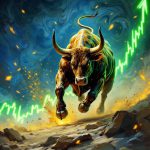Selling Climax: Panic Selling Creates Prime Buying Opportunities
March 5, 2025
Intro: Stand Alone or Sink Like a Fool
In the unforgiving battlefield of the stock market, following the herd isn’t just a mistake—it’s financial suicide. The market is a relentless predator; those who move blindly with the crowd become its easiest prey. To win, you must break free from the herd mentality, sharpen your strategic mind, and learn to exploit mass psychology rather than fall victim to it. This Stock Market Basics Course is not for the timid—it’s a war manual for traders who refuse to be slaughtered alongside the mindless majority.
The Psychology of the Masses: The Illusion of Safety
The herd rushes in when markets rise, convinced that momentum equals security. When markets crash, they flee in blind terror, fueling the selloff they fear. This is mass psychology—a self-reinforcing cycle of greed and panic. The crowd doesn’t think; it reacts, and reaction is the enemy of profit.
History is filled with brutal reminders. The dot-com bubble saw an irrational frenzy, as lemmings piled into worthless companies simply because everyone else was buying. The 2008 financial crisis? The same herd that laughed at warnings of a housing bubble was the same herd that screamed for the exits when the collapse came. The lesson? The herd is never right when it matters most.
Cognitive Bias: Your Mind is the Enemy
Even the smartest traders fall into psychological traps. Confirmation bias makes you seek out opinions that reinforce your bad decisions—the bandwagon effect tricks you into thinking that popularity equals wisdom. Anchoring bias keeps you clinging to old price levels when the game has already changed. These biases don’t just influence decisions—they destroy fortunes. The few who recognize and overcome them are the ones who survive when the bloodbath begins.
Lemming Theory: The Fatal Flaw of Imitation
Lemming’s theory is brutal: most investors don’t think; they copy. They buy because their neighbour is buying. They sell because the headlines tell them to. They chase hype, follow trends, and ultimately run straight off the cliff. Look at Bitcoin’s history—how many retail traders bought at the peak of every hype cycle, only to sell in despair when prices collapsed? The pros—those who don’t follow the herd—are buying when panic reaches its peak and selling when euphoria blinds the masses.
Break Free and Exploit the Weakness of the Masses
To win in the market, you must think independently, act decisively, and capitalise on the herd’s mistakes. When the crowd is euphoric, be sceptical. When they panic, sharpen your knife. Study mass behaviour, recognise the tipping points of fear and greed, and strike before the herd even knows what’s happening.
The #1 rule of trading is simple: never follow the herd. Be the wolf, not the sheep.
What is a Selling Climax? The Anatomy of a Market Meltdown
A selling climax is not just a selloff. It’s a market-wide capitulation—a liquidation frenzy where stocks plunge as investors abandon all logic. Volatility explodes, volume surges and weak hands surrender their positions at any price. This is where assets go from oversold to absurdly undervalued. And this is where the real money is made.
Historically, selling climaxes have marked major turning points. The 1987 crash? A brutal selling climax sent stocks plummeting—only for the market to recover and surge higher. The 2008 financial crisis? The ones who bought during peak panic made fortunes in the following years. The COVID-19 crash of March 2020? It is a golden buying opportunity for those who understand that mass fear is always temporary.
The Contrarian Playbook: Seizing Opportunity in the Eye of the Market Storm
The greatest fortunes in investing are forged not in moments of calm but during chaotic storms of fear. These are the moments when the market is gripped by panic, when rationality has evaporated, and herd mentality reigns supreme. Those courageous enough to defy conventional wisdom and implement a disciplined strategy can achieve extraordinary outcomes. The contrarian playbook? Sell puts amidst explosive volatility, buy calls during the depths of market despair, and decisively act when chaos peaks.
When markets descend into panic, volatility surges dramatically. The volatility index (VIX), aptly named the “fear gauge,” can spike above 40 or even higher during severe market crashes. This dramatic surge inflates put option premiums, creating lucrative opportunities for contrarian investors who dare to sell these inflated puts. Selling puts on fundamentally strong, high-quality stocks allows investors to immediately collect substantial premiums while positioning themselves to buy shares at attractive discounts if the market continues to decline.
Take, for instance, the dramatic COVID-19 market crash in March 2020. High-quality stocks like Apple, Microsoft, and Amazon suffered severe declines, causing put premiums to skyrocket. Contrarians who sold puts on these blue-chip names collected considerable premiums while preparing to own industry titans at bargain-basement prices.
Why Buy Calls? Leveraging the Violent Snapback Rally
Once the selling climax ends, markets often explode upward in equally dramatic fashion. Panic-driven selloffs rarely persist indefinitely, and the subsequent recovery can generate exceptional returns. Using the premiums collected from selling puts, contrarians strategically purchase long-dated call options (LEAPS) on oversold stocks. This approach positions investors to capitalize on the inevitable rebound, combining limited downside risk with impressive upside potential.
A clear historical example unfolded during the aftermath of the 2008 financial crisis. Following an extended and brutal decline, the S&P 500 commenced a powerful recovery in March 2009. Investors who seized the opportunity by acquiring calls on deeply oversold sectors such as financials and technology saw exponential returns as markets rebounded vigorously.
The Importance of Timing: Identifying the Selling Climax
Not every market dip provides a contrarian opportunity. Identifying the true bottom—a moment of extreme panic, capitulation, and exhaustion—is critical. Investors must carefully analyze specific technical and psychological signals to pinpoint this climax:
Volume Spikes: The heaviest selling typically occurs during the final phase of a crash. Extraordinary volume combined with massive red candles often indicates seller exhaustion.
Exploding VIX: Historically, a VIX reading above 40 signals extreme fear. In October 2008 and March 2020, the VIX surged beyond 80, marking peak panic moments and presenting extraordinary contrarian opportunities.
Bullish Divergences: When prices hit new lows but indicators like RSI or MACD show higher lows, selling pressure is likely fading.
Capitulation Wicks: Long lower candlestick wicks accompanied by high volume indicate aggressive dip buying—a key early reversal indicator.
Real-World Contrarian Data: A Fresh Perspective on Market Extremes
Contrarian investors thrive during market anomalies, and real-world data underscores the power of bold action during extreme fear:
March 2020 COVID-19 Crash: In mere weeks, the S&P 500 plunged more than 30%, and the VIX hit a record-shattering 82.69. Savvy investors who sold puts on fundamentally sound tech stocks—such as Tesla and Nvidia—captured substantial premiums. When markets reversed, Tesla surged over 700% by year’s end, delivering astonishing gains to contrarians.
2008 Financial Crisis: At the peak of pessimism, Bank of America shares traded below $5. Investors who boldly sold puts on major banks and simultaneously purchased LEAPS on broader market indexes profited immensely as the S&P 500 nearly tripled in the subsequent five years.
2023 Tech Selloff: Even smaller-scale selloffs can reward contrarian tactics. From late 2022 into early 2023, rising interest rate fears battered tech stocks, sending the Nasdaq 100 nearly 30% lower and inflating options premiums. Contrarians who sold puts and bought calls on undervalued companies like Meta Platforms and Microsoft benefited significantly when tech rebounded sharply in mid-2023.
Panic is a double-edged weapon. For most investors, it results in irrational decisions, forced selling, and profound regret. They follow the herd blindly, selling at the lows, watching helplessly as markets inevitably recover without them. The contrarian, however, thrives amid chaos. Equipped with a clear strategy, rigorous analysis, and emotional discipline, contrarians sell puts at peak fear, buy calls at the bottom, and ride the powerful recovery wave to outsized profits.
Mass Psychology in a Panic: The Mindless Stampede
Fear is a contagion; during a selling climax, it spreads like wildfire. The herd doesn’t think—they react. They see red, they panic, and they hit the sell button without a second thought. This is herd mentality at its most extreme. Retail traders, institutions, and even seasoned pros get caught in the chaos, selling simply because everyone else is selling.
This is where the prepared contrarian strikes. The selling climax isn’t a disaster—it’s a gift. While the masses are puking their shares, you step in and scoop up quality assets at rock-bottom prices.
The Market’s Greatest Secret: Chaos Creates Kings
The best trades aren’t born in comfort—they are forged in fear, carved from chaos, and executed in moments of sheer panic. When the herd flees, the news screams disaster. Screens bleed red—that’s when the battlefield is set.
The selling climax is the market’s moment of truth. Weak hands fold, their fear suffocating any rational thought. The crowd sees destruction. The strategist sees opportunity. This is where generational wealth is made—not by following, but by anticipating, by embracing discomfort while others crumble.
When the market is burning, you don’t hesitate—you strike. Because in the end, fortunes are transferred, not created. The only question is: Will you be the predator or the prey?
When chaos reigns, do you retreat? Or do you strike?
The Sculpted Mind
Q1: How can traders train themselves to recognize a true selling climax instead of just another market dip?
A1: Recognizing a true selling climax requires analyzing multiple indicators. Look for extreme volume spikes, oversold technical readings (such as RSI below 20), and widespread capitulation in sentiment—for example, financial media declaring the market “broken” or prominent investors turning bearish at the bottom. Additionally, liquidity dries up before the final flush, meaning price action becomes erratic before a violent, high-volume reversal.
Q2: What role does contrarian thinking play in surviving and thriving during extreme market downturns?
A2: Contrarian thinking is the backbone of successful investing during crises. When the herd is panicking, a contrarian sees forced liquidations and emotional selling as opportunities. However, being contrarian for the sake of it is dangerous—you need confirmation through technical signals, valuation metrics, and sentiment analysis to time your entry. The greatest investors—Buffett, Templeton, Druckenmiller—made their biggest gains by going against the crowd at the right moment.
Q3: How do smart money players manipulate mass psychology to maximize their gains during a market crash?
A3: Smart money exploits fear by allowing panic to escalate before stepping in. They use strategic short selling to accelerate the downfall, then quietly accumulate positions at rock-bottom prices while retail traders dump in despair. They don’t react to emotion—they create it. News cycles, analyst downgrades, and fear-driven narratives are often tools to push the herd toward capitulation, at which point smart money swoops in, ready for the next bull run.











